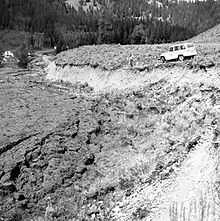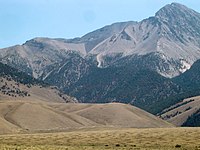Fault scarp
A fault scarp is a small step-like offset of the ground surface in which one side of a fault has shifted vertically in relation to the other.[1][2] The topographic expression of fault scarps results from the differential erosion of rocks of contrasting resistance and the displacement of land surface by movement along the fault.[3][4] Differential movement and erosion may occur either along older inactive geologic faults, or recent active faults.[5][6][7]
Characteristics[edit]
Fault scarps often involve zones of highly fractured rock and discontinuities of hard and weak consistencies of rock. Bluffs can form from upthrown blocks and can be very steep, as in the case of Pakistan's coastal cliffs.[8] The height of the scarp formation tends to be defined in terms of the vertical displacement along the fault.[9] Active scarp faults may reflect rapid tectonic displacement[10] and can be caused by any type of fault including strike-slip faults.[11] Vertical displacement of ten meters may occur in fault scarps in volcanic bedrock, but is usually the result of multiple episodic movements of 5 to 10 meters per tectonic event.[12][13]

Due to the dramatic uplift along the fault, which exposes its surface, the fault scarp is very prone to erosion. This is especially true if the material being uplifted consists of unconsolidated sediment.[14] Weathering, mass wasting, and water runoff can soon wear down these bluffs, sometimes resulting in V-shaped valleys along runoff channels. Adjacent V-shaped valley formations give the remaining fault spurs a very triangular shape. This formation is known as a triangular facet; however, this landform is not limited to fault scarps.[15]
Fault scarps may vary in size from a few centimeters to many meters.[16] Fault-line scarps are typically formed due to the differential erosion of weaker rocks along a fault. Such erosion, occurring over long time periods, may shift a physical cliff far from the actual fault location, which may be buried beneath a talus, alluvial fan or filled-in valley sediments. It may therefore be difficult to distinguish between fault scarps and fault-line scarps.[17]
Examples[edit]
- The Teton Range in Wyoming is an example of an active fault scarp. The dramatic topography of the Tetons is due to geologically recent activity on the Teton Fault.[18]
- Fault scarps in Motosu, Japan, created by the 1891 Mino–Owari earthquake.[19]
- The fault scarps bounding the East African Rift Valley.[20]
- The fault scarps bounding the Rio Grande Rift in New Mexico.[21]
- The Bree fault scarp of the Roer Valley in northeast Belgium[22]
References[edit]
- ^ Marshak, Stephen (2009). Essentials of geology (3rd ed.). New York: W.W. Norton. ISBN 978-0393932386.
- ^ "Faults" (PDF). ETH Zurich. 2020.
- ^ Easterbrook, Don J. (1999). Surface Processes and Landforms. Prentice Hall. p. 247. ISBN 978-0-13-860958-0.
- ^ Smith, Bernard J.; Whalley, W. B.; Warke, Patricia A. (1999). Uplift, Erosion and Stability: Perspectives on Long-term Landscape Development. Geological Society of London. p. 111. ISBN 978-1-86239-047-8.
- ^ Holdsworth, Robert E.; Turner, Johnathan P.; London, Geological Society of (2002). Extensional Tectonics: Regional-scale processes. Geological Society of London. p. 185. ISBN 978-1-86239-114-7.
- ^ Babar, Md (1 January 2005). Hydrogeomorphology: Fundamentals, Applications and Techniques. New India Publishing Agency. pp. 98–99. ISBN 978-81-89422-01-1.
- ^ Yorath, C. J. (2005). The geology of Southern Vancouver Island (Rev. 2005 ed.). Madeira Park, BC: Harbour Pub. ISBN 9781550173628.
- ^ Huddart, David; Stott, Tim A. (16 April 2013). Earth Environments: Past, Present and Future. John Wiley & Sons. ISBN 978-1-118-68812-0.
- ^ McCalpin, James P. (2 July 2009). Paleoseismology. Academic Press. p. 193. ISBN 978-0-08-091998-0.
- ^ Hilley, George E. (2000). Thrust Fault Slip Rates Deduced from Coupled Geomorphic and Tectonic Models of Active Faults and Folds in the San Francisco Bay Area: Collaborative Research with Arizona State University and University of California, Davis. Department of Geology, Arizona State University.
- ^ McCalpin, J.P.; Bruhn, R.L.; Pavlis, T.L; Gutierrez, F.; Guerrero, J.; Lucha, P. (2011). "Antislope scarps, gravitational spreading, and tectonic faulting in the western Yakutat microplate, south coastal Alaska" (PDF). Geosphere. 7 (5): 1143–1158. doi:10.1130/GES00594.1.
- ^ Strahler, Arthur N. (1960). Physical Geography (2nd ed.). New York: John Wiley & Sons, Inc,. p. 475.
{{cite book}}: CS1 maint: extra punctuation (link) - ^ Proceedings of the Workshop on Paleoseismology, 18-22 September 1994, Marshall, California. U.S. Geological Survey. 1994. p. 174.
- ^ Holtmann, Regina; Cattin, Rodolphe; Simoes, Martine; Steer, Philippe (8 March 2023). "Revealing the hidden signature of fault slip history in the morphology of degrading scarps". Scientific Reports. 13 (1): 3856. doi:10.1038/s41598-023-30772-z. ISSN 2045-2322.
- ^ Bucci, Francesco; Cardinali, Mauro; Guzzetti, Fausto (January 2013). "Structural geomorphology, active faulting and slope deformations in the epicentre area of the MW 7.0, 1857, Southern Italy earthquake". Physics and Chemistry of the Earth, Parts A/B/C. 63: 12–24. doi:10.1016/j.pce.2013.04.005.
- ^ Ramelli, Alan. "Prominent Fault Scarps in Western Nevada". Nevada Geology. Retrieved 13 May 2024.
- ^ Chorley, Richard J.; Dunn, Antony J.; Beckinsale, Robert Percy (1964). The History of the Study of Landforms: Or, The Development of Geomorphology. Geological Society of London. p. 19. ISBN 978-1-86239-249-6.
- ^ Byrd, J.O.D., Smith, R.B., Geissman, J.W. (1994) The Teton fault, Wyoming: Topographic signature, neotectonics, and mechanisms of deformation, Journal of Geophysical Research (99), No. B10, p. 20095-20122
- ^ Smits, Gregory (30 November 2013). "Earthquakes in the Early Modern Era". Seismic Japan: The Long History and Continuing Legacy of the Ansei Edo Earthquake. University of Hawai'i Press. pp. 1–36.
- ^ Ebinger, C. J. (July 1989). "I I Tectonic development of the western branch of the East African rift system" (PDF). Geological Society of America Bulletin. 101: 885–903.
- ^ Hudson, Mark R.; Grauch, V. J. S. (1 January 2013). New Perspectives on Rio Grande Rift Basins: From Tectonics to Groundwater. Geological Society of America. ISBN 978-0-8137-2494-2.
- ^ Vanneste, Kris; Verbeeck, Koen; Camelbeeck, Thierry; Paulissen, Etienne; Meghraoui, Mustapha; Renardy, François; Jongmans, Denis; Frechen, Manfred (2001). "[No title found]". Journal of Seismology. 5 (3): 329–359. doi:10.1023/A:1011419408419.


